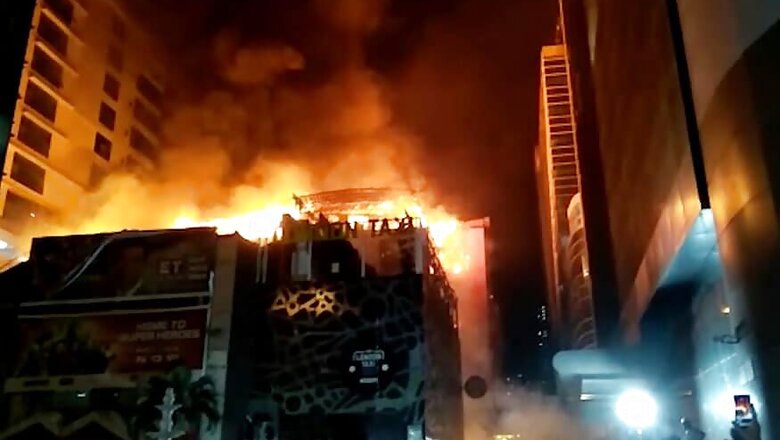
views
When a fire breaks out in a slum or a high-rise or a swanky pub in Mumbai, there is little surprise. There is little panic. There is only a familiar ‘there you go again’ reaction by the people living in the maximum city. The infernos have become a way of life here.
For us journalists, it is yet another day of standing near the blaze and the debris, scurrying to the hospital, taking a count of the dead and the injured, exposing the blatant violations and then fixing accountability. I have lost count of the number of fire mishaps I have covered as a television journalist in Mumbai.
Sometimes when there is nothing ‘newsy’ in the city, there is always something going up in flames in some corner of the city, that keeps us busy and sadly, relevant. Even as I was writing this, a building in Worli was engulfed in flames.
2018 was another year of unending fire tragedies. The burning apathy is appalling as the authorities, especially the BMC, is yet to wake up from its perpetual slumber. The statistics can shake up an average Mumbaikar. While in 2017, the number of deaths due to fire stood at 25, of which 14 people died in the Kamala Mills fire that occurred at the fag-end of last year, this year the total deaths from fire incidents have jumped to 43. A whopping 3724 incidents of fire have been reported in the city in 2018. More than 400 people have sustained injuries. If these numbers are not gut-wrenching, then I don’t know what is.
The Kamala Mills tragedy, I believed, was a jarring wake-up call for the civic body and its fire department to get its act together, or at least it seemed so. I thought it finally shook their conscience but the reality is far from it.
The BMC had sprung into action after the tragedy and more than 30,000 inspections were conducted and action taken on about 10,000 commercial establishments. Many others were fined and pulled up for non-compliance. What’s tragic is that it was just a knee-jerk reaction and nothing more.
A resident of Worli, Sheetal Jai, explains, “I saw civic officials closing the shutters of a few restaurants last year, only for them to spring back up again a few months later. And many more have opened in the surrounding areas and really nobody to check if they have all the permissions in place. Even if they don’t, they will continue to operate because there is connivance between the civic officials and the builder or the management. Corruption is so rampant that there is no value for human life.”
Sheetal is right. No lessons have been learnt and Mumbai continues to be ravaged in flames every other day and human lives continues to be treated cheaply. Two weeks ago, ESIC hospital fire in Andheri killed 11 people, including newborns.
Three days ago, five people, including four senior citizens died when their homes in a high-rise caught fire in Chembur. The last few weeks saw a spate of back-to-back fire incidents during the holiday season. It’s almost as if we are helplessly watching the city burn even as those responsible are unconcerned and unaffected.
Ask anybody in the city, a chaiwala or a banker, they will tell you about the dangerously crumbling infrastructure of the city. There is haphazard construction, cramped buildings, diminishing open spaces and to top it all, there are no proper and regular fire audits and inspections conducted to check on building wirings, in-built fire-fighting equipment and their maintenance.
The justification — there are too many buildings and structures in every nook and cranny and too few men to do regular checks. Even a 10-year-old can tell you about the gross violations of fire safety norms in hotels, high-rises and commercial establishments that go unchecked.
The Mumbai fire brigade, on its part, has a multitude of responsibilities. It has to fight the fire, prevent it and inspect the buildings for fire-safety systems. A senior fire brigade official says, “We have too much on our plates. We need separate departments and cells for inspections, compliance and for non-fire activities such as tree falls, oil spill or bird/animal rescue.”
PS Rahangdale, the chief fire officer, says his firemen are on their feet 24/7 and that they carry out regular inspections. “We do preliminary inspections and give the NOC but modifications and alterations are made by the builders. We pin them down and send notices when we do the audits. But our men can’t possibly stand at every eatery or apartment to do checks at every given point. Sometimes the onus is on the builder, architect and the management as well.”
Once a fire breaks, the challenge in the city is for fire brigade to get access to the affected buildings that are usually blocked by narrow, congested alleys and then the lack of inbuilt fire-fighting systems in tall buildings which makes it difficult to douse the fire efficiently, leading to casualties.
As Pankaj Joshi, an urban planner puts it, “The key is prevention. There is no need to fight so much fire if it can be prevented in the first place. And when the city is waking up to fire accidents every day, it only means the buildings were not checked for compliance, which needs to be done every six months. How often do we see our buildings getting routinely inspected for fire safety? Almost never.”
He adds that strong guidelines and laws are in place but they are bent and allowed to be broken. “Fire safety components are non-negotiable. Buildings should be sealed if even a single component, be it fire exit doors, refuge area or an extinguisher, is missing. Today, whenever audits are conducted, many violations are accepted by the auditors. They let go of the violators or just pocket some bribe. There is absolutely no accountability. Why is there such callousness?” he asks.
It’s clear that the problems are various – right from the stage of granting fire NOCs to routine inspections, rules are brazenly flouted. Apathy is the real culprit. The incidents of fire coupled with tragedies such as stampedes, cave-ins, bridge and building collapses in Mumbai point towards a city that is being torn at the seams.
That combined with negligence, rampant corruption and lawlessness has made Mumbai a dangerously unliveable city. Even as Mumbai’s tryst with tragedies continue, is it too late for us to hope for the city to come back to its revived, glorious self?




















Comments
0 comment